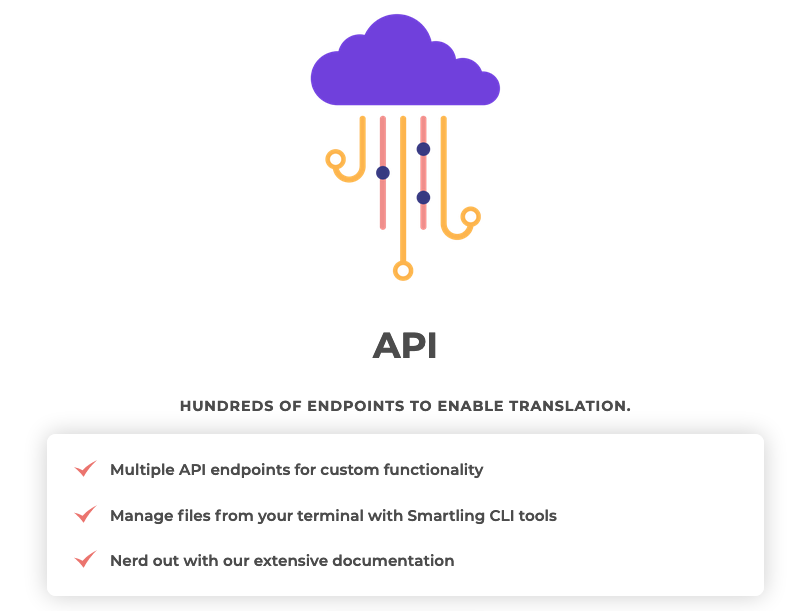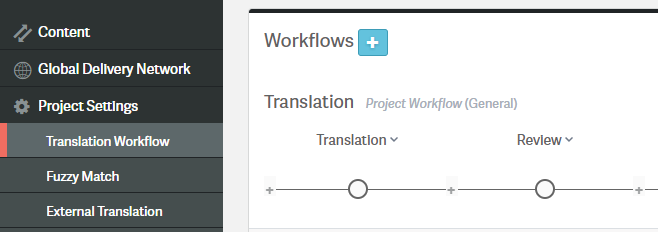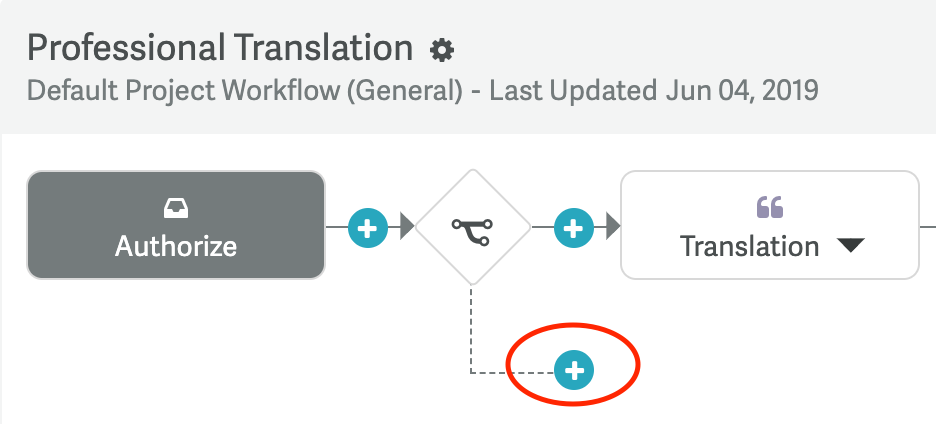One of the first questions people ask is “does Smartling provide automated translation?” Well, that’s a little bit of a trick question. Let’s explore why.
What is Automatic Translation?
While the concept of automated translation isn’t quite in-line with science fiction just yet, we’re quickly getting there. In fact, Smartling automation can already provide an incredibly powerful advantage when it comes to both managing and translating content.
To better understand just how powerful Smartling’s automated translation software really is, our first question to answer then comes down to “what is automated translation?”
Smartling enables users to automate the tasks surrounding content management and the process so that linguists are free to focus on translation, and content always ends up where it needs to be without repeating the same tasks.
Automatic Translation vs Machine Translation
Automation is an incredibly powerful tool that enables users to focus on their important tasks at hand, instead of spending time repeating the same basic workflows.
Simply put, automation enables users to configure automatic tasks within their technology tools (like Smartling) that are initiated through specific triggers. The platform will then carry out those specific tasks or follow-up actions based on the determined trigger.
For translation management, this is less about automatic translation, and more about automating the process. The traditional localizaiton process typically involves manually exporting and importing files into a CMS, preparing files for translation, emailing files between developers, localization managers and translation agencies and so on. Instead, automatic translation through an automated process can simplify the entire workflow.
Naturally, many will think first about Machine Translation when we hear the term “automated translation.” However, Machine Translation is really just one element of automated translation tools.
When it comes to Automatic Translation, in most cases, organizations will be utilizing human translators to transform and localize the content. Smartling Automation therefore doesn't necessaraialy provide automatic translation, but rather enables users to simplify the entire process surrounding this critical work. So, this isn't necessaraialy automatic translation, but rather an automated process.
For example, once content is submitted to the platform, Smartling can be automated to bundle that content into a job, and assign that job to the appropriate translator.
By connecting, outlining, and simplifying the overall content translation process, Smartling makes it easier for users to manage their content, and for translators to convert that content
Understanding Automatic Translation
To make the distinction as clear as possible, it is important to recognize that when we discuss Automated Translation, we are referring to the entire platform as a whole: all steps from the beginning to the end, and any touchpoint within the process of initiating, translating, managing and publishing content. Not automatic translation powered by machine translation.
It is the entire process surrounding the actual human translation that is automated, enabling users to focus on the important tasks. With automation, content will constantly be flowing throughout the Smartling platform without human intervention. This is what enables companies to translate more and more content without adding headcount to manage the process of translation.
Not all automations are created equally, either. Teams can decide what to automate, and configure specific workflows when they see fit. Users are free to create as many or as few automations as they need to simplify the process.
For example, automated workflows can be used to help manage your content delivery.

By integrating directly with your team’s Content Management System (CMS), marketing automation platform, web app or mobile app, translated content that is approved can be automatically sent to, and uploaded, and published without any manual intervention.
The idea, of course, is to remove as much friction as possible within the entire process, saving you both valuable time, and money.
The Power of Smartling Automation
To illustrate just how automatic Smartling can be, we are going to highlight some specific features and functions that truly enable your team to automate the translation process.
Automated Workflows
Users can establish automated workflows for their own individual tasks, projects, or even organization wide automations for use in the entire Smartling platform.

Within Translation Workflows specifically, teams can set a number of different actions to be automated, including:
- Content Assignment
- Primary Action
- Skip Steps, for example Skip Internal Review step if string’s Translation Memory (TM) match is over 90%, or skip Editing Step if string’s TM is over 80%
- Reject Content
- Pre-publish all translation
Automatic workflows make it easy for users to clear out the clutter and repetitive actions in order to focus on higher priority tasks.
Dynamic Workflows
With Dynamic Workflows, users can setup and design their own workflows based on their specific needs, and link multiple actions to one trigger.
Smartling utilizes “Decision Steps” to establish a dynamic workflow. These decision steps are used to evaluate a specific string’s properties, so the correct action can then be taken.

For example, users can establish a Dynamic Workflow to initiate when a string received a fuzzy score over or under a determined threshold.
Any strings with high fuzzy scores can then be sent to a Human Translator. Any strings with a lower fuzzy score can be sent to the next step in the process, to Machine Translation or Internal Review.
The major benefit in utilizing a Dynamic Workflow is that users no longer have to manually decide whether to put content into a workflow for human translators, or a separate workflow for Machine Translation. You just dump all content into one workflow, and the workflow figures it out for you, saving crucial time.
Real-Time Quality Check
Looking a little bit beyond designing workflows and their related actions, another unique example of Automated Translation includes real-time Quality Check.
By configuring specific Quality Check notifications, users can create an automated process that ensures translations cannot move forward in the process when an issue is recognized.
Depending on the exact piece of content, or priority of that content, different quality checks can be performed by Smartling, including:
Translation Consistency
- Number Consistency
- Segment Completeness
- Glossary Compliance
- Punctuation Consistency
- Global Capitalization Consistency
- Segment Completeness
Spacing and Target Length Limit Errors
- Leading or Trailing Spaces
- Spacing Error
- Target Length Limit
In fact, the Quality Check can even be configured to look for target language word misspellings, repeated words and target or source written in the wrong language. Going even further, users can even assign priority levels to these Quality Checks.

Optimize Around Automations
To help save even more time, Smartling measures a wide number of metrics and provides deep analytics to help teams optimize and perfect their entire process.
With Workflow Velocity Reports, users can determine how much time content is spending within each stage of the process, allowing users to identify where automations might be too slow, or where improvement is necessary.
With Workflow Change Reports, Smartling provides the necessary data and information allowing users to better understand the exact value that workflow step is adding towards improving overall translation quality.
In the end, Smartling provides powerful automation and the tools needed to constantly evolve and improve. Through these reports, users might uncover a bottleneck within the process that would have gone unseen before.
Where Translation Becomes Automatic
We are rapidly moving towards the level of technology previously limited to science fiction, leveraging both Artificial Intelligence and Machine Learning. Both of these technologies can help power true automatic translation.
Smartling Draft
First announced at our Global Ready Conference 2019 in San Francisco, our team is working hard on Smartling Draft. This new Natural Language Generation tool will almost act as automatic translation, and help teams ensure the highest level of translation quality by maintaining consistent tone and language during the initial writing process.
Draft provides authors with previously used phrases, leveraging a “translation memory” that can be automatically customized to specific organizations.
By utilizing known phrases and terms, authors can stay consistent with brand voice, and simplify the translation process at the same time.
Global Delivery Network
As the fastest and most cost effective way to deploy multilingual websites, Smartling’s Global Delivery Network can often be confused for an automated translation method.
The GDN sits between an organization’s content, and the end-users device, to deliver translated content as soon as it is requested.
Once your website receives a request in a different language, the GDN responds and instantly exchanges existing English content with your professionally translated content. That translated version of the website is then delivered to the end-user.
Again, what is important to note is how the translation itself is not automated, but rather the delivery of translated content. The process surrounding the translation, and the action of delivering that translated content, is automated.
The Final Word
So, with all that we can now return back to our original question, “Does smartling provide automatic translation?”
And the answer is that Smartling does more than that. Smartling enables organizations to ultimately optimize their process of content management and translation through the use of powerful automation tools. For example, translation jobs can be automatically submitted for review after completion, or content can be moved between repositories without the need to drag-and-drop from one location to another.
When it comes to expanding your brand globally, Smartling’s powerful automation tools are there to handle the heavy lifting, allowing the actual content to stand strong.

![How to Create Business Value With Terminology Management [Infographic]](https://go.smartling.com/hubfs/Imported_Blog_Media/DA20210817_-_How_to_Create_Business_Value_with_Terminology_Management_-_1200x675_-_Twitter_____2_2x.jpg)




